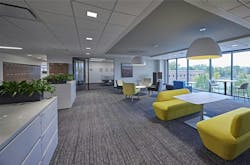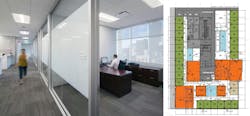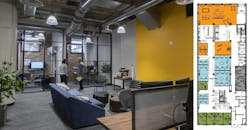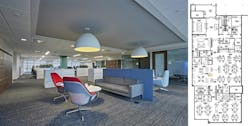Mastering office layouts: 5 primary models for maximum efficiency and productivity
When laying out an office, there are many factors to consider. It’s important, obviously, to maximize the space, but it’s equally important to make sure the design allows employees to work efficiently. It’s crucial to keep in mind not just the number of people who will be utilizing the office but also how they’ll be using it.
The first step in coming up with a plan is to ask lots of questions.
Does every individual need his or her own workspace? Does it make sense to have shared workspaces? How many private offices are needed and where should they be located within the design? Is there a need for large conference rooms or flex spaces? Knowing the answers will help guide final layout decisions.
5 Primary Office Layouts and Strategies
Knoll developed a Workplace Planning Approach that has been utilized on several of our recent workplace projects. Here are the five primary office layouts and the benefits to each along with some layouts and images of projects that align with these models.
1. Perimeter
In this design, private offices are located around the perimeter of the floor plan with workstations in the middle. This tends to be used in a more “traditional” office setting and is based primarily on the hierarchy of the individuals, in which you allocate more space to the people higher up in the organization.
The work areas are stationary and fixed and there are clear, prescribed circulation paths among them. This works well when most of the work is done independently. Collaboration and activity spaces are large, formal, and enclosed.
2. Core
Core layouts shift the private offices and conference rooms to the interior. On the perimeter are open workstations where most of the team is working the majority of the time.
This provides for a more open feeling and gives more employees access to natural light. There is a connection among workspaces with long sightlines and a mix of open and enclosed activity spaces.
3. Efficient
This is ideal for places like call centers because it provides more compact, densified work settings that can accommodate a larger number of people. In this strategy, there are few private offices and more open areas with low horizons and longer sightlines.
The workstations tend to be closer together with narrow pathways to maximize the number of employees who can use the space. Efficient workspaces are often more streamlined and energetic.
4. Adaptive
Adaptive designs work well when a company needs a mix of private or single-person workspaces as well as areas for collaboration and activity. Meeting areas are flexible, meaning they can be easily adapted to solitary work or to joint work. Offices are dual function and can serve several purposes so that employees can find a private area to work when needed but also have access to spaces that can bring people together.
They are typically interwoven throughout the office so that they’re in proximity to all employees. In these plans, there are ample conveniences and amenities with plenty of places for social gathering.
5. Immersive
Immersive spaces are very similar to adaptive ones, but sometimes require less square footage. These would be utilized when a portion of the team works remotely or hybrid and you don’t need to allocate a desk for everyone.
The work settings tend to be inviting with comfortable furnishings and hospitality-style amenities. There are fluid boundaries so that employees can use the space however they decide. From one day to the next, each space could be utilized differently and there are blurred lines between solo work areas and collaborative ones.
Overall
Choosing which layout strategy is best for your office can be tricky, especially as the workforce evolves in this post-pandemic world.
Many companies are finding that the layout that used to work well no longer does and they need to re-think their space. Having a clear understanding of what employees need to do their best work will help guide design decisions that focus on efficiency, productivity, and comfort for everyone.





